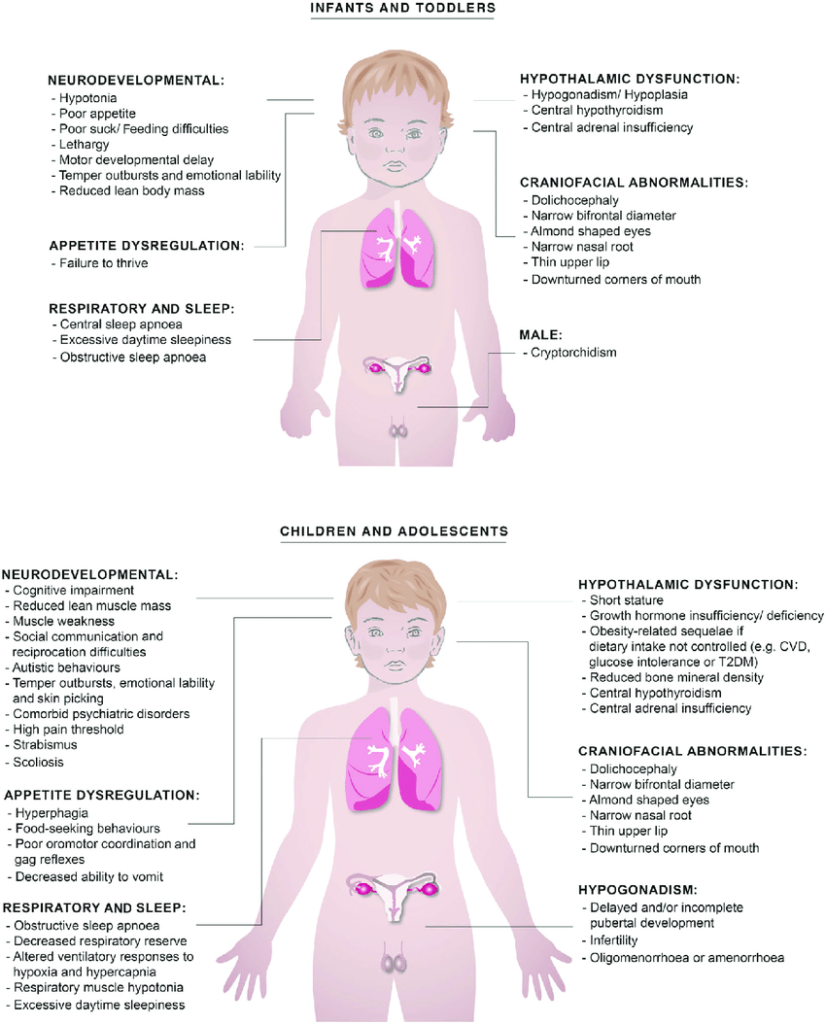
Caused by an abnormality on chromosome 15, this syndrome is congenital and is generally physically characterised by obesity, narrow-shaped eyes, small stature, and small hands and feet. Symptoms such as decreased muscle tone and delayed motor development are also associated with the syndrome.
It ought to be remembered that each student with Prader-Willi syndrome is an individual and any one student with the syndrome will have different strengths and needs from another. Most students have some degree of general learning disability, usually in the mild range. A minority of students have been noted to have an IQ (Intelligence Quotient) of 100 or above on standardised IQ tests. Students’ reading and writing skills are often better than number skills and abstract thinking. Short-term auditory memory can be weak. However, long-term memory is considerably better.
The student will often excel at sedentary activities such as computer work and colouring. Difficulties can present emotionally and socially. It is important to understand that the student’s behaviour is part of the syndrome and not usually intentional. Poor co-ordination and balance may also be observed. Affected students have an intense craving for food and may go to extreme lengths to get it. This results in uncontrollable weight gain.
Atypical Prader-Willi Syndrome: some students may have a diagnosis of Prader-Willi syndrome but will not have the typical physical features.
Acquired Prader-Willi Syndrome: symptoms associated with Prader-Willi syndrome can be ‘acquired’ by damage to, or a dysfunction of, the hypothalamus (the hypothalamus is the part of the brain that controls body temperature, cellular metabolism, and functions such as eating and sleeping). In these cases, the student will not have any of the genetic abnormalities and few of the physical characteristics of the syndrome; however, the behavioural and appetite problems that are associated with the syndrome may present. Learning and teaching techniques effective with students with true Prader-Willi syndrome can also be helpful when working with students with acquired Prader-Willi syndrome.
Strategies for Learning and Teaching
- Overlearning and repetition will be necessary if the student has a poor short-term memory.
- If the student is a literal thinker, he/she may find tasks involving the use of imagination challenging. Consider incorporating real-life experiences and concrete examples into lessons.
- Many students with Prader-Willi syndrome tire easily. This needs to be considered throughout the school day and new concepts and materials are best introduced early in the school day.
- Social skills may need to be explicitly taught.
- The student with Prader-Willi syndrome may have poor auditory processing skills, which will have an impact when following instructions. Visual cues may need to be considered in this area to assist the student.
- The student may have difficulties with gross-motor skills, which may necessitate modifications to lessons such as Physical Education. Concrete objects and experiences should be utilised in the teaching of Mathematics.
- If the student appears frustrated when completing a task, consider breaking it up into sections for the student to complete.
- In dealing with inappropriate behaviour, note that many students with Prader-Willi Syndrome respond well to a positive-behaviour reward system.
- Discuss the approach to dietary control to be adopted by the school with the parent/carer. Consult also as to how to best deal with food-taking tendencies in the school situation.
- Some students find it difficult to work in groups: consider this when adapting the teaching process.
- Consistency of routine is very important, so if change in a routine is about to occur ensure the student is warned in advance.
- Within the teaching of Physical Education the student may need extra praise and encouragement to engage in tasks.
- Be aware that students with Prader-Willi Syndrome can have a high pain threshold.
- Computer work appeals to many students and this should be considered as a means for the student to engage with new material and as an alternative way to demonstrate learning.


